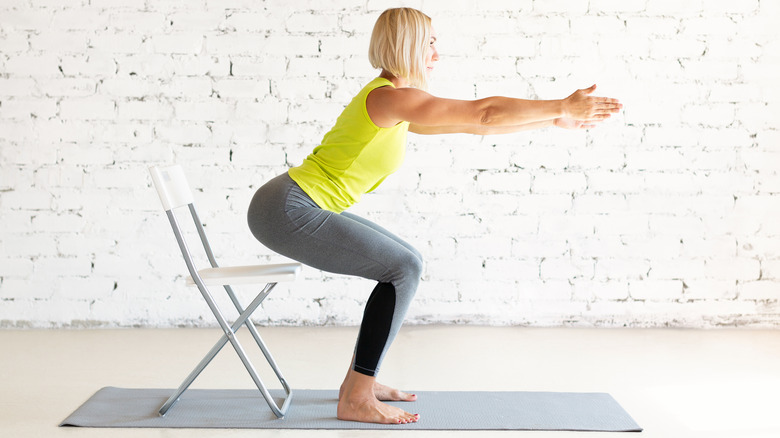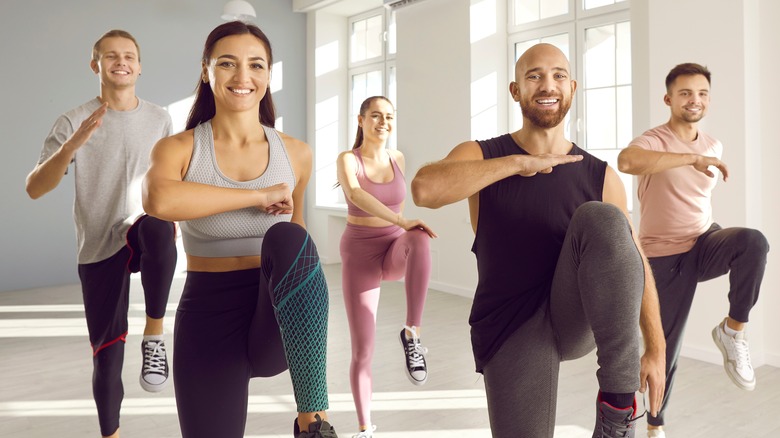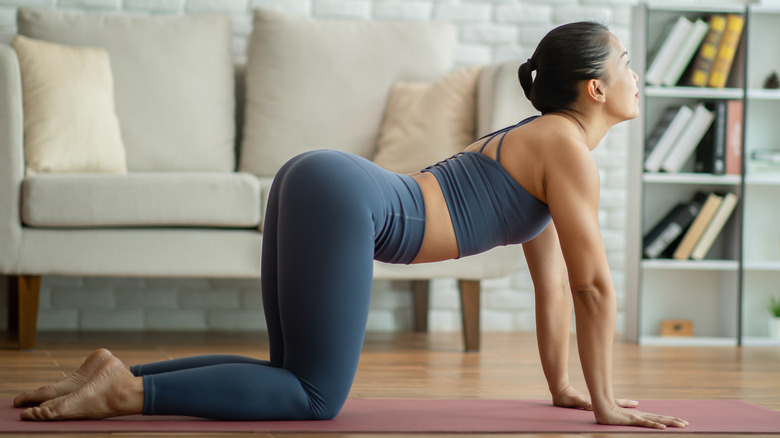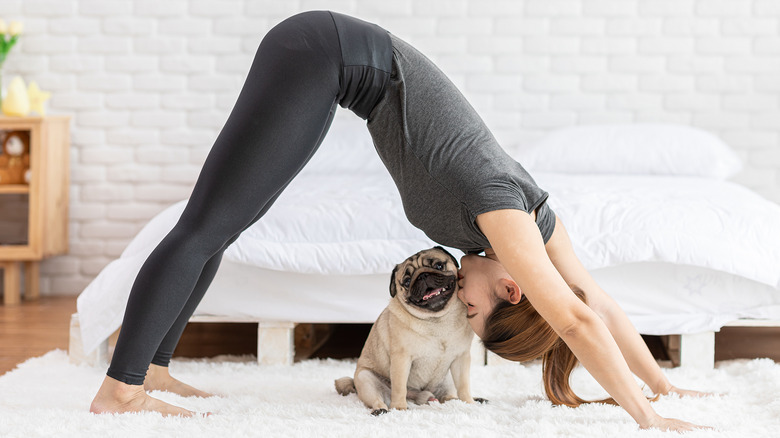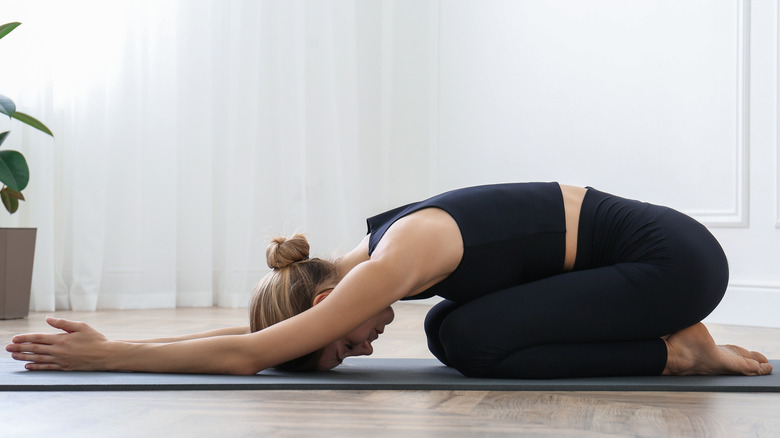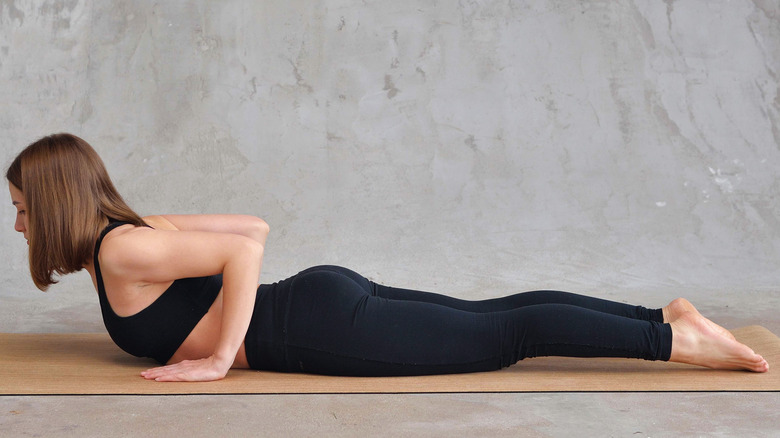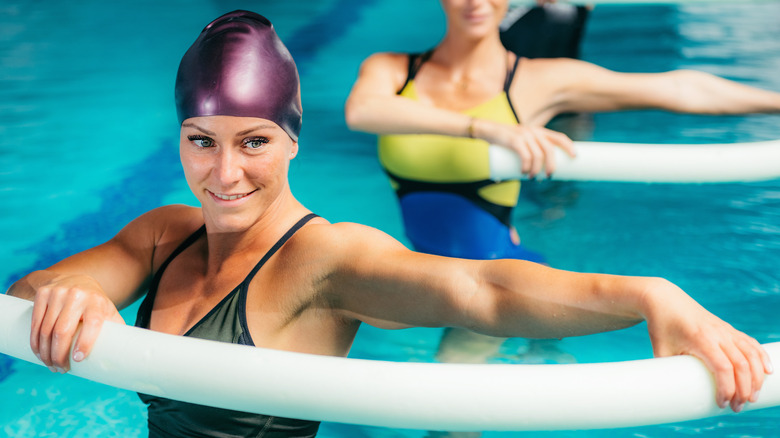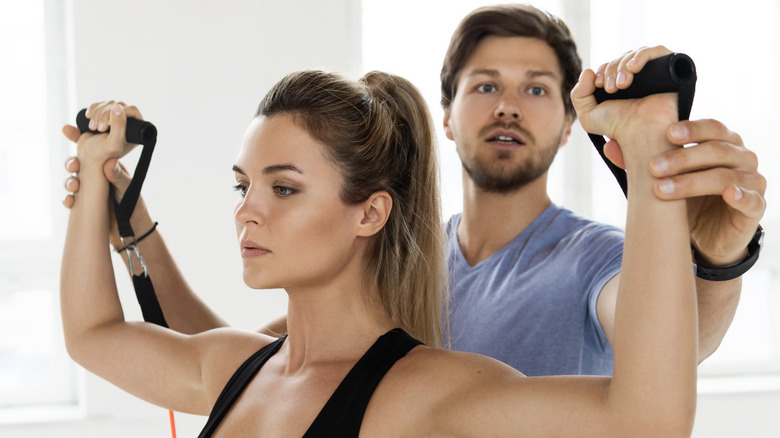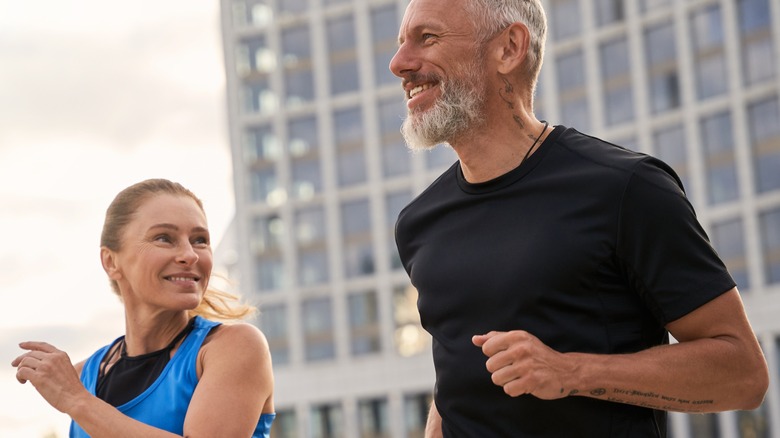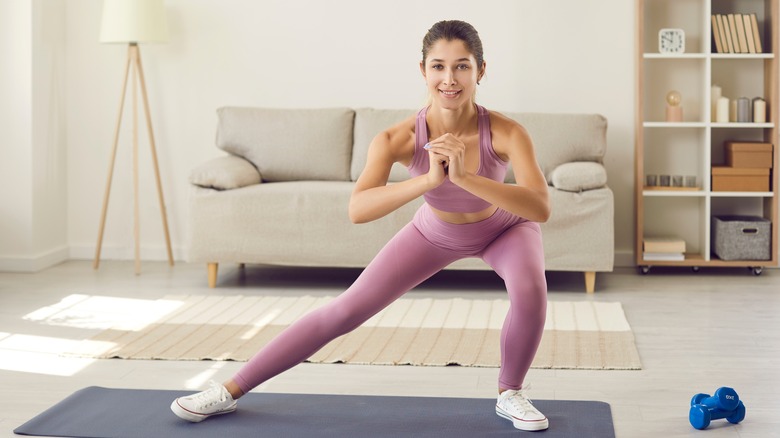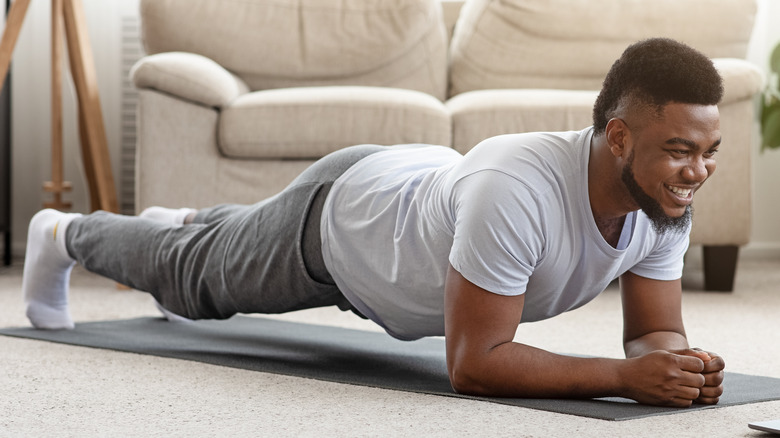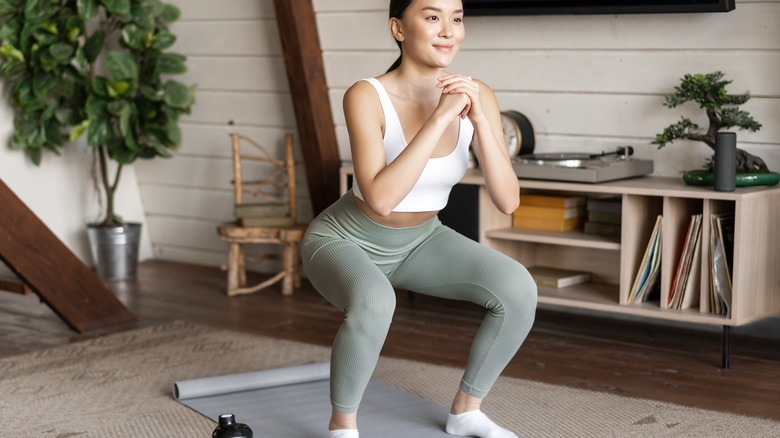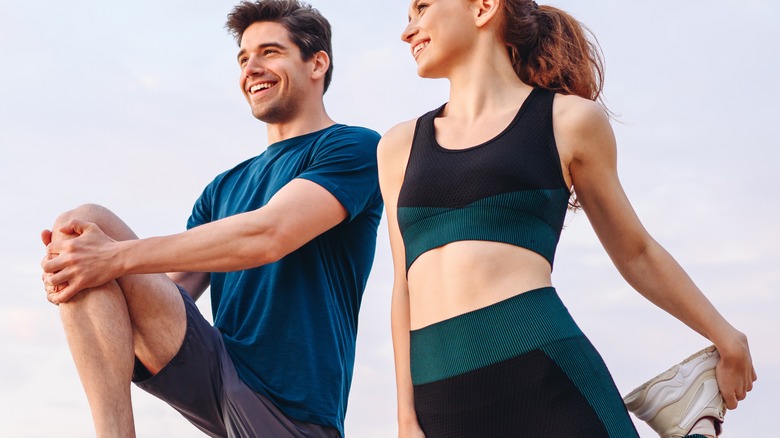The Best Exercises For People With MS
It may sound surprising, but people with multiple sclerosis (MS) should be following the exercise recommendations of the American Heart Association: 150 minutes of cardio exercise per week, 2 non-consecutive days of strength training, and at least 10 minutes of stretching twice a week (via National MS Society and Penn Medicine). In fact, research shows that the benefits of exercise outweigh the challenges of MS (via the Mayo Clinic), which include numbness, muscle weakness, and coordination challenges (per a 2021 review in the Journal of Multiple Sclerosis).
Still, it can take time to adjust to exercise when your body is challenged. It is not uncommon for individuals with MS to experience blurred vision, numbness, and tingling at the beginning of a workout (via the Mayo Clinic). This is due to core body temperature increases during exertion. Symptoms will typically dissipate once the body's temperature cools down. It is important to build up slowly to improve strength, flexibility, and balance so as not to over-exert oneself.
While MS is a chronic disease, it affects people differently. There are some with mild symptoms and little to no disability, while others endure steadily worsening symptoms with decreased disability over time. The good news is that there can be long stretches of relief, with either full or partial recovery. And exercise can be incorporated at any level, as modifications can be made to meet one's individual needs (per the Mayo Clinic).
Yoga
Yes, managing daily tasks may be more difficult for some with MS. But yoga can help, as it focuses on balance, strength, and body alignment, all of which can be challenged by the disease (via the National MS Society). Furthermore, the relaxation benefits of yoga can help with the discomfort of treatment including withstanding the duration of MRI examinations and having to receive injections or infusions. It can also help one to remain calm when MS symptoms are exacerbated.
In fact, yoga is a popular complementary and alternative medicine (CAM) option to help patients with MS reduce or overcome their symptoms, according to a 2020 review in the Journal of Ayurveda and Integrative Medicine. (CAM is defined as "a group of diverse medical and health care systems, practices and products that are not presently considered to be part of conventional medicine," according to the National Institutes of Health.) Many studies involving yoga-based interventions have reported reduced pain, stress, and anxiety, as well as enhancing strength, balance, and overall self-reliance.
Cardio and strength training
For those concerned that exercise might aggravate the pain or worsen MS symptoms, this may not be the case. In fact, research shows that exercise improves symptoms, says Diana Duda, PT, DPT, MSCS, a physical therapist at Penn Therapy and Fitness at Rittenhouse and a Multiple Sclerosis Certified-specialist, in an interview for Penn Medicine. Cardio and strength training improves fitness, strength, and endurance.
According to a 2017 article in BMC, aerobic training at low to moderate intensity can improve fitness and reduces fatigue in MS patients with mild to moderate debilitation. Even better, numerous studies have shown that strength training, aerobics, and a combo of both, have improved the muscle strength in those with MS – across various subject populations and protocols, according to a 2015 review in Therapeutic Advances in Neurological Disorders.
Duda recommends that cardio (exercise that increases the heart rate) should be done at moderate intensity for 150 minutes per week. She also recommends strength training — to support muscle fitness — at least twice a week. These goals are in line with physical fitness recommendations via the American Heart Association. She suggests getting in 10 minutes per day of stretching to ease muscle tightness, and always taking the time to warm up first.
Cat-cow pose
The cat-cow pose helps warm up the back, elongate the spine, and creates body awareness (via Health Central). This pose can be done in a chair if getting on one's hands and knees is too difficult.
Start by kneeling on the floor (via the Mayo Clinic). In a table-top position, place your hands shoulder distance apart and knees right below the hips. Inhale as you curve your lower back and lift your chin, providing a slight tilt of the pelvis (cow). Exhale as you draw your belly inward while arching your back to the ceiling. Tilt your head and pelvis toward the floor (cat). Then, repeat the process. A slow and methodical transition between "cow" and "cat" will help loosen the torso muscles (via Health Central).
You may also perform this exercise in a chair, if you need more support. For this modification, start by sitting with your feet flat on the ground (via Yogapedia). Sit tall with your buttocks in the middle of the chair. Place your hands on your thighs. Inhale as you open the chest, allowing the back to arch. Then, exhale and round the back, drawing your chin toward your chest. Slowly repeat.
Downward facing dog
Downward facing dog activates the muscles of the body, primarily from the waist down (via ISSA), through lengthening stretches. It also contributes to upper body strength. What's more, it may help reduce fatigue, which affects 80% of people with MS (via Above MS).
Start on your hands and knees, keeping your fingers spread wide and hands shoulder width apart (via ISSA). Curl your toes under, straighten your knees, and raise your pelvis toward the ceiling. Exhale to move your chest toward your knees, as you lengthen the legs and press your heels toward the floor. It's okay if your heels don't touch the ground (via Health Central). Keep your head in line with your arms. To modify this for better ease, begin in a kneeling position as described above (via ISSA). Extend the arms out front and keep the knees on the floor, with a focus on stretching the upper body. This takes pressure off the wrists and hamstrings, which is ideal for those with weaker muscles.
Warrior II pose
Those with MS may experience lows in self-esteem when their physical body is challenged (via MS International Foundation). But practicing the warrior II pose may be useful in easing those woes. In fact, it is one of several yoga poses that can boost self-esteem via integrating mindfulness, while building flexibility and improving strength (via First Post). This pose strengthens the limbs, inner thighs, and the core (via Health Central). It also helps to improve balance, focus, and confidence.
For this standing pose, you'll start off by opening your legs into a straddle, about two to four feet apart. Turn one foot toward the front of the mat (turn your gaze in that direction) and bend your front knee, so it is directly over your toes. But keep your torso facing the long side of the mat. Raise your arms into a "T," extending the arms and fingers in opposite directions. For those challenged with balance, you can do this pose parallel to a wall for support (via Yoga Journal). Place a yoga block between your thigh (front leg) and the wall and press into it for stability.
Child's pose
This pose is ideal for calming the mind and relaxing the body (via Health Central). It also provides a gentle stretch for the spine, shoulders, and hips. According to a 2015 study in Archives in Bone and Joint Surgery, pain in the shoulders and upper back is common to individuals with MS. It is important to practice within your range of flexibility (via Every Day Yoga).
Start on your hands and knees. Bring your toes together and spread your knees apart. Lower your buttocks onto your heels. On an exhalation, bow forward to rest your torso between your thighs. Drop your forehead to the floor. Extend your arms and press into your palms to press your buttocks closer to your heels. Breathe into the pose for one minute or longer. For deeper relaxation, place the arms alongside your thighs with your palms facing up. Modification tip: If you have difficulty resting your buttocks onto your heels, place a folded blanket between your thighs and calves for added support.
Cobra pose
For those with tight backs and sore necks (that's most of us), cobra pose may provide some relief (via CNY Healing Arts). And dedicating some time to this pose may ease stress and anxiety, which is often associated with those dealing with MS (via Johns Hopkins Medicine). This pose can be done on the floor, with or without props, and even modified for a supportive chair stretch (the least challenging of the three), via Yoga Journal.
Place a mat on the floor and lie on your belly. Place your palms onto the floor by your chest. If you need extra support, place a small, folded blanket under your chest with your palms onto the blanket. Inhale as you gently press your torso upward, lengthening the spine. Exhale as you gently release your torso back to the mat. Modification tip: Sit in a chair placing your legs together. Either place your hands on your hips, grab the sides of the chair, or interlace your fingers behind your head. As you inhale, lengthen your spine, and squeeze your shoulder blades together. Then, exhale to return to your upright seated position.
Water aerobics
Oh, the unique properties of water — buoyancy, viscosity, and hydrostatic pressure! And it's these properties that can be especially beneficial for those with MS (via the Multiple Sclerosis Society of America).
Buoyancy and hydrostatic pressure (pressure exerted evenly in all directions) support posture and balance, especially for those affected by weakness and balance challenges. The viscosity of the water provides a gentle resistance that can be eased or intensified as it responds directly to the velocity (speed in a given direction) of one's movement, according to a 2017 review in the American Journal of Lifestyle Medicine.
Water aerobics can also help ease muscle tension and improve flexibility, while providing a heart-pumping cardio routine (via Everyday Health). You may use water weights, pool noodles, and other pool workout tools to increase the effectiveness of your workout. To prevent overheating (as it can intensify MS symptoms), the National Multiple Sclerosis Society recommends a pool temperature of 80 to 84 degrees Fahrenheit.
Shoulder press
A shoulder press is ideal for building upper body strength. But you don't need weights to get the benefits of this exercise (via Health Central). Using resistance bands can give you the resistance you need. And because they are portable, inexpensive, and accessible to all fitness levels, they are an ideal prop for this (and many other resistance-bearing) exercises (via Healthline). As the shoulder joints are complex and more prone to injury, a resistance band can offer a safe, effective, and versatile option for this exercise.
Place a resistance band on the floor and step in the middle with your feet shoulder distance apart (via Health Central). While gripping the ends of the band, palms facing forward (elbows pointing down), raise your hands to your shoulders. While engaging your core, slightly bend the knees and extend your hands above your shoulders. Be careful not to arch your back. Pause, and then lower your hands to your shoulders to complete one repetition. You may strive to complete two to three sets of eight reps, resting 30 to 60 seconds between each. As resistance bands become more resistant the further they are stretched, allowing more slack (not fully extending your reach) will provide better ease if needed.
Run/walk (or jog intermittently)
So, you may not love to run, but there is evidence that any degree of running, even if it's more of a jog, can significantly improve fitness in those with MS (via Overcoming MS). Improving mood, muscle strength, and endurance is just a sampling of its benefits. But more importantly for those with MS, it can help boost neurons in the brain for a neuroprotective effect. According to a 2017 review in Physiology, running can have a rapid effect on neurotransmitters (i.e., the chemical messengers that enable the body to function), as well as blood flow for circulation.
Ease into running (although you don't have to actually run if that's too exacerbating). Starting with short jogs combined with walking can be effective (via Overcoming MS). This will prevent muscle strain from performing any physical activity that's too intense. Be sure to plan your "run" around those times when you have more energy. And most importantly, be sure to stretch beforehand. Keeping those muscles and ligaments more flexible is important for preventing injury and pain.
Remember that there will be good and bad days, so listen to your body to determine when a run/walk is appropriate for you. If you feel heaviness and stiffness that makes it difficult to move, plan on better time when your body is more responsive.
Side shuffle with lunge
For improving speed and coordination, the side shuffle can enhance your one's agility in lateral movements (via Your House Fitness). It targets the abductor and adductor muscles in the hips for a good stretch.
A side shuffle can be an ideal warm up as it boosts your cardio fitness and flexibility (via Spotebi Fitness & Nutrition). Stand with your feet slightly wider than hip distance apart (toes pointing forward). Bend your knees and hinge at the hips (squatting with your hips over your ankles). Take a few quick steps to the left and then lunge left, and reach toward your left foot with your right hand. Repeat in the opposite direction. If a succession of quick paced steps followed by a lunge is too taxing, do a single step shuffle instead. Once in the squatting position, take just one step to the side followed by the other foot. Then, repeat on the other side.
Plank
The plank is a core-strengthening exercise that also targets your hips, buttocks, obliques, and your back (via Podium Runner). And core strength is especially important for people with MS, as it helps with balance and coordination (via Everyday Health). Strengthening your hips and butt are also integral for balance and gait, via a 2021 review in the International Journal of Environmental Research and Public Health.
Start by lying on your belly, face down onto a mat (via Everyday Health). Prop yourself up onto your elbows and curl your toes under. Align your elbows below your shoulders. Press into your toes to lift yourself, while maintaining a flat back (your body is positioned in a long line, parallel to the floor). Then, squeeze your glutes and quadriceps as you hold this plank position for 10 to 15 seconds. Repeat for three to five sets. You may increase to 20-second holds as you get stronger.
Squats
Squats are a form of strength training that uses your body as resistance (via Everyday Health). This exercise works your lower body muscles, strengthening the quads, hamstrings, and glutes. Leg and glute strength is important for enabling everyday activities (i.e., walking, standing, bending), per Everyday Health).
You can tailor your squat to your level of fitness, but a traditional squat begins in an upright stance (via Medical News Today). With your feet shoulder width apart and toes pointing forward, bend your knees and hinge at the hips. Keep your back straight and head in line with your shoulders, as you aim for a 90-degree bend in the knees. Press into your feet to straighten back to standing. To modify this pose, you may start by sitting up tall in a chair with your feet shoulder distance apart and a 90-degree bend in your knees (via Everyday Health). Hinge at the waist and shift your weight forward. Press into your heels to stand up, engaging your glutes and quads. You can use the chair to assist in balance. Repeat your ideal squat 10 to 15 times.
Workout tips
Starting any new exercise can be a challenge, especially if you have MS. But there are guidelines to keep it doable, effective, and conducive to maintaining a consistent routine. Start slow and build up your endurance over time to prevent over-exertion or injury (via Overcoming MS). In other words, pace yourself, listen to your body, and gradually increase intensity as your body permits.
To keep it fun and safe, choose exercises you enjoy and use modifications when necessary to support your needs. If weights are too daunting, do exercises with resistance bands or that only require your own body weight. Invite friends and family to join you, if you fear your balance and coordination may be a bit off at times. And as with any physical activity, always remember to warm up before and stretch afterward (via the Mayo Clinic).
Before starting any new exercise routine, it is important to consult your doctor (per the National MS Society). To prevent exacerbating symptoms, be sure to mind your body temperature. Stay hydrated to keep it low. Exercising during cooler times can also help prevent overheating while exercising.

